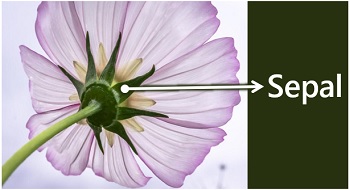Sepals and petals differ more or less based on their colour, shape and size. Petals are fluorescently coloured with a symmetrical or asymmetrical shape, and their size varies from plant to plant.
In contrast, a sepal in most flowers appears green in colour with varying shapes and sizes. A flower is dichlamydeous when a perianth has distinct calyx and corolla.
The calyx is a collective term to indicate a group of sepals in the outer whorl. Corolla is a collective term representing a group of petals in the inner whorl.
This post explains the key differences between sepals and petals and the comparison chart. You will also get to know the definition and similarities between the two.

Content: Sepals Vs Petals
Comparison Chart
| Properties | Sepals | Petals |
|---|---|---|
| Meaning | Sepals are green-coloured, leaf-like structures that protect the bud or inner whorl | Petals are modified leaves enclosing the flower’s male and female reproductive parts |
| Collective term | Sepals in the outermost whorl are collectively termed as “Calyx” | Petals in the inner whorl are collectively termed as “Corolla” |
| Location | They constitute the outer whorl | They constitute the inner whorl |
| Colour | They appear inconspicuously green coloured | They appear conspicuously bright-coloured |
| Size | Sepals are comparatively smaller in size | Petals have large-size |
| Appearance | Sepals appear leaf-like | Petals appear coloured leaf-like |
| Role in budding and blooming | They provide protection to the flower bud until it’s ready to bloom against extreme conditions | Petals open up during the flowering stage to expose the flower’s reproductive parts |
| Role in pollination | No role | They are involved in attracting pollinating agents through vivid colours and scents |
Definition of Sepals
Sepals are the modified leaves that constitute the outermost whorl of the flower. These leaf-like structures keep the flower intact during the budding stage.
Sepals in the outer whorl of the flower are collectively called a calyx. Thus, a sepal is a unit of the calyx. The union of sepal appendages often forms another whorl called a whorl of bracts.
A whorl of bracts resembles sepals and is present outer to the calyx. The length and thickness of a sepal vary among different plant species.

Usually, the number of sepals could be between two to five but vary in different flowers. We can classify different plants by knowing the size, number and arrangement of sepals.
- Some sepals occur free (polysepalous).
- Some are fused together (gamosepalous).
After fertilization in flower, sepals wither or become vestigial. But, some may remain intact with the fruit.
Definition of Petals
Petals are the modified leaves that constitute the second outer whorl of the flower. These petaloid surround the flower’s male and female reproductive parts.
Petals exist in different colours, shapes and sizes. The characteristic feature of petals is that they are brightly coloured, attracting pollinators. For this reason, petals play a significant role in the pollination process.
Petals in the inner perianth are collectively called the corolla. Thus, a petal is a unit of the corolla.

Generally, the structure of petals comprises:
- Broader upper part (blade)
- Narrow lower part (claw)
Petals can be symmetrical or asymmetrical. Eudicot or dicot flowers generally have four or five petals. In contrast, monocot flowers have three or six petals. We can also classify plants by knowing the size, number and arrangement of petals.
- Some petals occur free (polypetalous).
- Some petals are partially fused together (gamopetalous).
After fertilization in flowers, petals are useless, and they wither and fall off.
Facts
- When the sepal and petal have the same colour and are indistinguishable, then the perianth of the flower is known as tepals. Tulips, Magnolia etc., are examples having indistinguishable perianth.
- The fusion of tepals (petals and sepals) is referred to as sympetalous.
- When the perianth of the flower resembles a sepal or appears green, then a flower is called a sepaloid.
- When the perianth of the flower resembles a petal or appears colourful, then a flower is called a petaloid.
Key Differences Between Sepals and Petals
-
- Sepals are usually green leafy structures forming an outermost layer of the flower. In contrast, petals are the colourful structures forming a second layer of the flower.
- A group of sepals in the outermost layer of the flower is collectively known as calyx. In contrast, a group of petals in the second outer layer of the flower has collectively termed the corolla.
- A sepal is comparatively smaller, whereas a petal generally has a large size.
- The majority of flowers have green leaf-like sepals and colourful leaf-like petals.
- Sepals provide mechanical support and protection during the flower’s budding stage. Petals participate in pollination by attracting pollinators through vivid fluorescent colours and scents.

Similarities
- Both are modified leaf-like structures.
- Sepals and petals together form a perianth.
- They both are the non-reproductive structures of a flower.
- Both safeguard the reproductive units (androecium and gynoecium) of a flower.
Conclusion
Thus, the sepal and petal together constitute the flower’s non-reproductive part or perianth. Merosity is the basic number of parts within each whorl. The number of sepals and petals in the perianth (outer whorl) varies depending on the plant species.
Then, coming into the shape, size and colour, both sepals and petals differ. Not only structurally but functionally they also differ that we have discussed in this post.